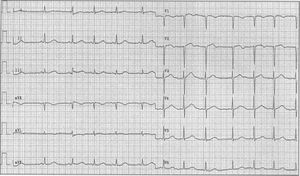I Think a Niece of Mine was Referred to a Neurologist
| Author(s) | A.A.M. Wilde, T.A. Simmers | |
| NHJ edition: | 2007:4,157 | |
| These Rhythm Puzzles have been published in the Netherlands Heart Journal and are reproduced here under the prevailing creative commons license with permission from the publisher, Bohn Stafleu Van Loghum. | ||
| The ECG can be enlarged twice by clicking on the image and it's first enlargement | ||
In the setting of family screening, an 84-year-old lady was invited for a cardiogenetic evaluation. Two of her grandchildren are known with a symptomatic long-QT syndrome type 2 based on a mutation in the KCNH2 gene (E698X). Two of her daughters, among whom the mother of the two affected grandchildren, have been identified as asymptomatic carriers. Based on the autosomal dominant inheritance pattern of the disease either she or her deceased husband should be (or should have been) carrier of the mutation. She has been asymptomatic her whole life and her ECG is completely normal (not shown). Her husband died at the age of 74 years from cancer; he had not been known to have suspect symptoms either; no ECG was available. None of her eight brothers and sisters, nor their children and grandchildren had had any complaints. Just before leaving our clinic, she suddenly remembered that a 14-year-old niece (a daughter of one of her youngest sister’s sons) had been seen by a neurologist because of syncope. Because every syncope in a family member is suspect, it is our policy to ask for an ECG.
The ECG was taken and sent to us (figure 1). It turned out to be of a 14-year-old girl who had had three episodes of syncope. The first occurred without a specific trigger at the age of 12, in the middle of the night. The second and third were probably triggered by emotion. After the third syncope she was referred to a neurologist who started valproic acid despite normal neurological evaluation (including EEG). She had no further syncope.
The question now is whether further evaluation is needed.
